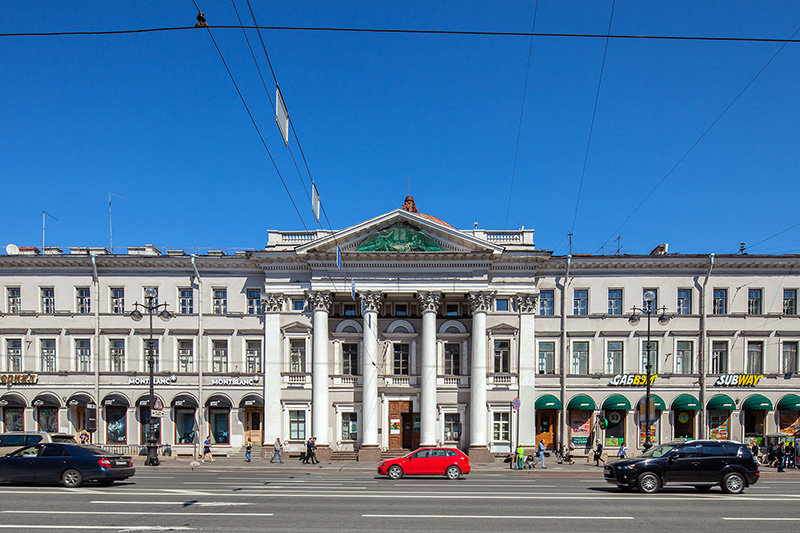French walk No.2 - Beaux arts of St. Petersburg
Our second French sightseeing route through St. Petersburg begins on Ploshchad Iskusstv (Arts Square). Unsurprisingly, this centre of cultural life in the city has numerous connections with France. First of all, the State Russian Museum has scores of works by French artists who came to live and work in St. Petersburg, among them Louis Caravaque, Jacques-Francois-Joseph Swebach de Fontaine, Balthazar de La Traverse, and the sculptors Nicolas-Francois Gillet, and Marie-Anne Collot. Not far from the Russian Museum, the Mikhailovsky Theatre was for more than 80 years home to the French Opera Company of the Imperial Theatres, which was considered to rival the finest theatres in Paris.

Opposite stands the Assembly of the Nobility building, designed by French architect Paul Jaquot. Here in the 19th century, some of the most famous figures in European music gave concerts, including Hector Berlioz, Camille Saint-Saens, and Claude Debussy. Their music is still played here today in the building's new guise as the Grand Hall of the St. Petersburg Philharmonia. The salon of the Counts Vilegorskiy (at No. 4) was another musical centre of the city, and the famous French artists that played there included the violinist Alexandre Bouchet, the harpist Aline Bertrand, the French horn player Eugene Leon Vivier, and the pianist Marie-Felicite-Denise Moke-Pleyel.
As we walk down Mikhailvoskaya Ulitsa to Nevsky Prospekt, we see on our right the Grand Hotel Europe, where several French celebrities have stayed, including the writer Theophile Gautier, Debussy and, much more recently, Catherine Deneuve.

We come out on Nevsky Prospekt right opposite Bolshoy Gostiny Dvor, the city's most famous department store, originally built by Jean-Baptiste Vallin de la Mothe to accommodate foreign traders. Modelled on Parisian shopping arcades, it once contained several French boutiques, a branch of Credit Lyonais, and the Russian restaurant Brenfo. Turning right along Nevsky Prospekt, we soon come to the Catholic Cathedral of St. Catherine, built to plans by Jean-Baptiste Vallin de la Mothe. This beautiful church was truly a centre of French life in St. Petersburg, counting amongst its congregation Charles, Comte d'Artois (the future Charles X of France) and the architects Thomas de Thomon and Auguste de Montferrand. One of the greatest military leaders of the Republic, Jean Victor Marie Moreau, is buried here.
Continuing along Nevsky, we come to the Engelgardt House at No. 30, which in the 1790s was rented a certain I. Lion, a French entrepreneur famous for his balles masquerades. Reconstructed by the French architect Paul Jaquot, it is now the Small Hall of the St. Petersburg Philharmonia, and has seen several notable performers, including Pauline Viardot. In the same building from 1838 to 1900, Henry Brocard, the "perfume king" had his store. Across the Griboedov Canal from the Engelgardt House, the Singer Building (Dom Knigi), an Art Nouveau masterpiece, was designed by Paul Suzor, son of the French-born writer and Russian politician Jean de Suzor.

Further along Nevsky Prospekt, we pass No. 24, which was once a famous French restaurant, Chez Dominique, and the Dutch Reform Church building (No. 20), also built by Jaquot, outside which in the 19th century several French traders had popular bookstalls. The neighboring building was once home to the famous patisserie Wolf and Beranger, while No. 15 was another popular French restaurant belonging to Pierre Talon, a favourite haunt of St. Petersburg's jeunesse doree.
Here we turn left along the Moyka River Embankment, passing the Palace of Hetman Kirill Razumovsky, another work by Jean-Baptiste Vallin de la Mothe. At the restaurant Kontan at No. 58, the Russian government honored its alliance with the French President Raymond Poincare, who was so moved by Fyodor Chaliapin's rendition of La Marseillaise that he awarded the great bass the Legion d'Honneur. At No. 85, Auguste de Montferrand, architect of St. Isaac's Cathedral, spent the last years of his life. Finally, we come to New Holland, for which Vallin de la Mothe built the spectacularly grand neoclassical archway into the shipyards.

From here we turn left along Ulitsa Glinka, which brings us to Teatralnaya Ploshchad. Here, at the Mariinsky Theatre and before that at the Bolshoy Kamenniy Theatre (where the St. Petersburg Conservatory now stands), a string of great French dancers and choreographers laid the foundations of Russian national ballet, among them Charles Didelot, Jules Perrot, Arthur Saint-Leon, and the greatest of them all, Marius Petipa, who made the Imperial Mariinsky Theatre the greatest ballet company in the world, and whose ballets are still a major part of the theatre's repertoire to this day. Ideally, you can time your walk to end in time for a performance, giving you the chance to see France's greatest contribution to the city of St. Petersburg.







